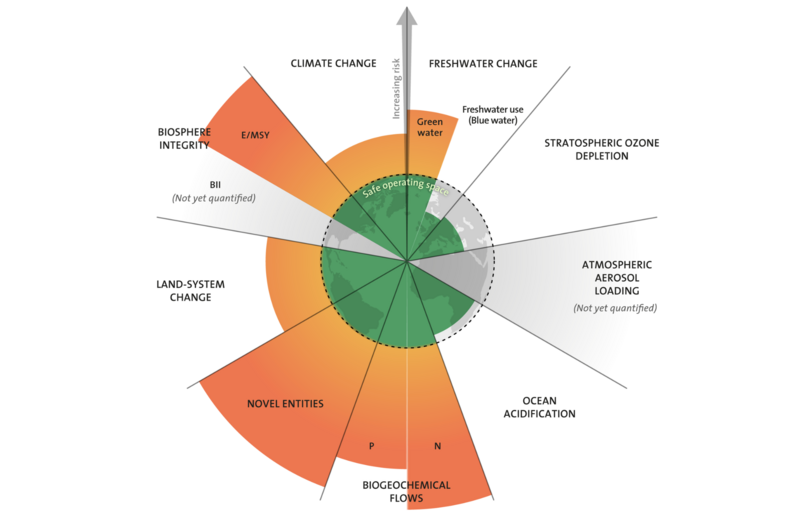Planetary Boundaries
The clock is ticking! With the Earth's resources under threat, it's time to take action: By respecting planetary boundaries, we can ensure that the Earth's systems can continue to support life as we know it.
The Planetary Boundaries framework is a scientific concept that identifies and quantifies the nine critical Earth system processes that regulate the stability and resilience of the planet's biosphere. The concept was introduced in 2009 by a group of scientists led by Johan Rockström and is updated ever since.
The nine Planetary Boundaries are:
Climate Change:
The level of atmospheric CO2 concentration, which has a significant impact on global temperatures and the climate system.Biosphere Integrity:
The loss of genetic diversity, species extinction, and ecosystem degradation.Land-System Change:
The impact of human land use on ecosystems, such as deforestation and urbanization.Freshwater Change:
The impact of human use of freshwater resources on the hydrological cycle and water availability.Biogeochemical Flows:
The alteration of natural nitrogen and phosphorus cycles by human activities, such as agriculture and fossil fuel burning.Atmospheric Aerosol Loading:
The amount of human-produced particles, such as soot and smog, in the atmosphere, which can impact human health and the climate system.Stratospheric Ozone Depletion:
The impact of human-made chemicals, such as CFCs, on the Earth's ozone layer.Ocean Acidification:
The impact of increased atmospheric CO2 on the pH balance of seawater and the health of marine ecosystems.Novel Entities:
The impact of human-made chemicals on the Earth's biosphere and human health.
The Planetary Boundaries framework posits that these critical Earth system processes define the safe operating space for human civilization. Any transgression of these boundaries could lead to irreversible environmental changes that have far-reaching consequences for human well-being. As such, this framework provides a valuable tool for policymakers, researchers, and the public to comprehend the potential risks and outcomes of human actions on the planet's biophysical systems.
The implementation of the Planetary Boundaries concept entails identifying specific boundaries and developing policies and practices to maintain them. For instance, reducing plastic pollution to remain within the safe operating space for chemical pollution is a way to foster sustainable development within planetary boundaries. The chemical pollution boundary concerns the impact of human-made chemicals on the Earth's biosphere and human health, including persistent organic pollutants (POPs), heavy metals, and plastic waste. Plastics, due to their durability and persistence in the environment, are significant contributors to this boundary. Plastic waste can accumulate in landfills, oceans, and other natural habitats, causing harm to wildlife and ecosystems, and potentially entering the food chain. Additionally, the production and disposal of plastics contribute to greenhouse gas emissions, contributing to the Climate Change boundary, and require significant amounts of fossil fuels, contributing to the Nitrogen and Phosphorus Cycles boundary. Consequently, addressing plastic pollution is an essential aspect of meeting the Planetary Boundaries framework's goals, and many initiatives are underway to reduce plastic waste, increase recycling and reuse, and transition to more sustainable materials.
One of the Planetary Boundaries framework's strengths is its comprehensive approach to environmental management, addressing multiple critical Earth system processes simultaneously, and allowing policymakers to prioritize interventions to tackle the issues. The framework is grounded in the most recent scientific research and is evidence-based, ensuring that it reflects the most up-to-date knowledge and understanding of the Earth's biophysical systems.
However, the Planetary Boundaries framework faces various challenges, including complexity, uncertainty, trade-offs, and implementation. The complex nature of the framework can be challenging to communicate to non-expert audiences, limiting its potential impact on public awareness and behavior change. Uncertainty and debate persist regarding some of the boundaries' precise thresholds and interactions, which can complicate decision-making and policy development. Furthermore, achieving all the Planetary Boundaries simultaneously is a challenge, and there may be trade-offs between different boundaries, such as economic growth and environmental protection. Finally, implementing the Planetary Boundaries framework requires significant changes in behavior, policy, and technology, which can be difficult to achieve, given the different social, cultural, and economic contexts of different regions and countries.
The Planetary Boundaries framework is a valuable tool for addressing global environmental challenges and guiding environmental policy and management decisions. However, its implementation presents challenges that must be tackled effectively to achieve its goals. The role of plastics in this framework is significant, as plastic pollution is a significant contributor to the Chemical Pollution boundary, and addressing plastic waste is a critical aspect of meeting the framework's goals.


